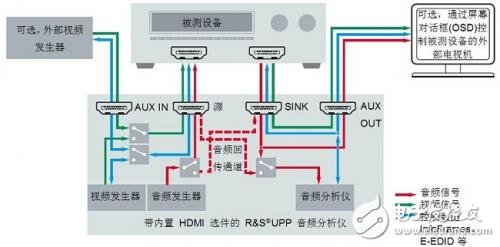How to make HDMI measurements
Mr. Klaus Schiffner from Rohde & Schwarz explains what HDMI is and how it should be evaluated. By way of example, he describes how to use the R&S UPP audio analyzer for HDMI testing.
High-DefiniTIon MulTImedia Interface (HDMI) has become a must-have standard for the consumer electronics industry. This interface allows audio and video signals, as well as InfoFrames, to be carried on a single cable. To measure audio on this interface, the test instrument must be able to generate and evaluate test signals for the entire HDMI format, including video signals.
HDMI is a further development of the Digital Visual Interface (DVI) in the consumer electronics industry, which first appeared on the market in 2003. Unlike DVI, it also transmits audio signals. This interface simplifies the operation of multimedia devices by streamlining the cable. According to the requirements of the film industry, it is largely able to prevent illegal copying of digital video movies. As the screen resolution increases and the color reproduction capability increases, the HDMI transmission bandwidth is also greatly increased. In addition, it is now possible for users to operate all connected devices with a single remote control via HDMI. This capability is also integrated into the HDMI standard.

Figure 1: For HDMI audio analysis, video and audio data must be generated and analyzed. This picture shows Rohde & Schwarz's UPP audio analyzer, which is capable of HDMI testing of up to eight surround channels simultaneously using the R&S UPP audio analyzer.
The current HDMI version 1.4b supports bidirectional data transmission (using an audio return channel), a new lossless compressed audio encoding method, and an Ethernet connection channel. With the advent of the newly defined micro HDMI connector, the interface has gradually found a way to connect mobile phones and portable audio devices, and the new lock-in connector allows it to be used in vehicles now. All of these features make HDMI the most successful and versatile connector system in the audio and video world. All state-of-the-art TV sets, DVD and Blu-ray players, A/V receivers and game consoles are connected to one another via HDMI cables. Digital multichannel audio signals with surround sound and high definition TV signals can be transmitted on the same cable.
Numerous interfaces
Consumer electronics manufacturers need to fully measure audio as they develop, test and produce their devices and audio chips. If the product is equipped with an HDMI interface, manufacturers need to be able to test audio signals, as well as audio analyzers that transmit InfoFrames and video signals. In addition, the audio analyzer must be able to provide all conventional audio interfaces:
â— Several analog channel XLR inputs for testing speaker output signals, headphone output signals, and preamplifier output signals
â— S/P DIF format (Sony/Philips digital interface), connector for BNC and TOSLINK digital audio interface
â— Digital I2S interface (inter-IC audio interface) for multi-channel audio IC testing in both directions of transmission and reception
Test requirements vary widely. The test instrument must be configurable to handle any combination of interfaces. The audio analyzer must be able to send an I2S signal to the chip and then analyze the chip's HDMI output. The audio analyzer adds the HDMI test signal to the A/V receiver input and then tests the audio quality of the receiver's analog speaker output or headphone output. The digital output can be tested via an S/P DIF cable or HDMI audio return channel. For example, in addition to verifying the correct channel assignment, the audio analysis of the surround sound transmission also includes whether the audio signal can be transmitted correctly.
Comprehensive audio measurement
HDMI is divided into dual channel and 8-channel data structures. Using an 8-channel data structure, up to 8 digital audio signals (surround channels) are transmitted as linear PCM data, with PCM data words up to 24 bits long and a sampling rate of up to 192 kHz. HDMI can also deliver compressed data streams, including compressed streams using Dolby technology.
Fast and efficient testing of 8 channel transmissions requires the test instrument to have 8 parallel channels. The audio analyzer can simultaneously generate up to eight independent test signals in HDMI or I2S format, or it can measure up to eight HDMI, I2S or analog input signals in parallel. Unlike dedicated HDMI testers, audio analyzers provide comprehensive audio signal testing including parameters such as level, frequency response, crosstalk, SNR, THD+N, and phase. In addition, it can generate sinusoidal signals and multi-audio signals for intermodulation measurements, as well as burst and noise signals, and play voice and music signals. The most advanced audio analyzers are able to:
â— Play Dolby Digital and Dolby Digital Plus encoded data streams and decode them for real-time measurements
â— Analysis of modulation factor
â— Measurement of Frequency Distortion Distortion (DFD), DC voltage and group delay
â— Implement Fast Fourier Transform (FFT) on 8 channels simultaneously in millihertz resolution
â— Display time domain track
FFT analysis provides a detailed spectral representation of the signal that can be used to detect individual noise components when measuring total harmonic distortion and noise (THD+N).

Figure 2: For example, the R&S UPP-B4 option with 4 HDMI ports can be used with the R&S UPP Audio Analyzer for HDMI testing.
Plug-In Connecting Terminals,Insulated Spade Terminals,Cable Connector Double Spade Terminals,Vinyl-Insulated Locking Spade Terminals
Taixing Longyi Terminals Co.,Ltd. , https://www.lycopperterminals.com
